Callistemon rugulosus
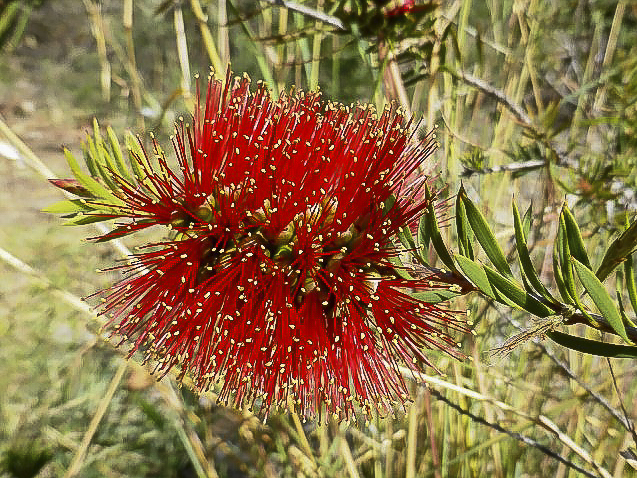
Callistemon rugulosus is known as the Scarlet Bottlebrush and in the wild will develop into a straggly shrub up to four metres tall. In our cold climate garden annual pruning has kept this species to a compact two metres. The bark is grey and peels. The leaves are thick and rigid, up to 50 millimetres long, seven millimetres wide and crowned with a pungent point.
Callistemon ‘Pink Champagne’
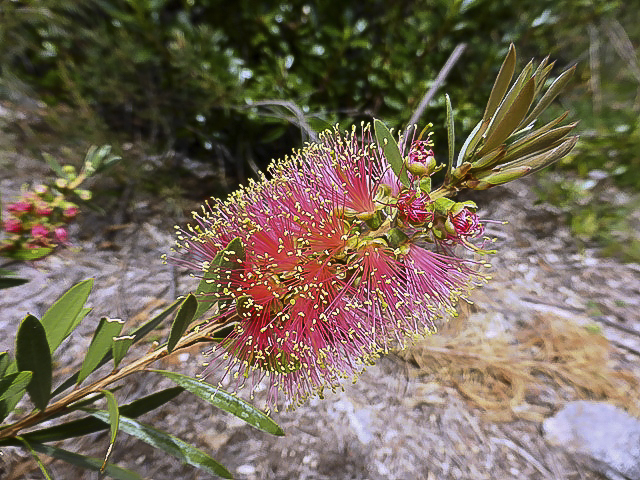
Callistemon ‘Pink Champagne’ develops into a dense, upright shrub that will reach a maximum height of three metres with a spread of two metres. The leaves are lance-shaped, grey-green, aromatic and fairly stiff. The distinctive feature of this cultivar is the large soft pink flower heads with yellow anthers. Blooms fade to white as they age.
Callistemon pinifolius
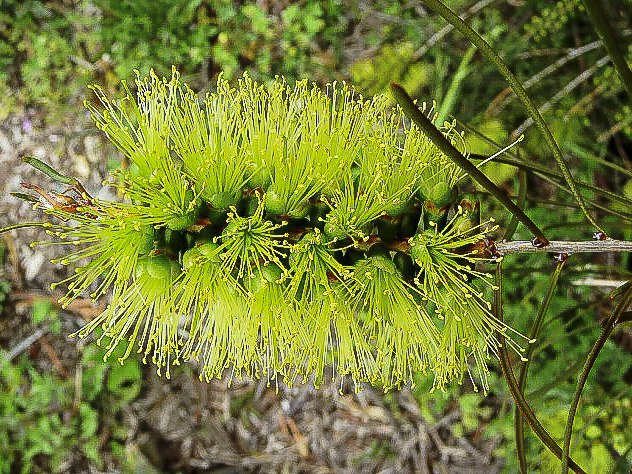
Callistemon pinifolius, the Pine-leaved Bottlebrush, is an open shrub that reaches a height of 1.5 metres with a similar spread in our cold climate garden. The leaves are narrow, about ten centimetres long with a sharp point. Flower spikes may be bright lime-green or red.
Callistemon phoeniceus

Callistemon phoeniceus is one of only two Callistemons endemic to Western Australia and is known as the Lesser Bottlebrush. The significance of this name escapes us but perhaps there was a comparison with Callistemon glaucus, the other WA bottlebrush.
Callistemon ‘Packers Selection’

Callistemon Packers Selection’ is a small shrub reaching a height of 1.5 metres with pendulous growth habit. The narrow leaves are four centimetres long by four millimetres wide. The narrow leaves are four centimetres long by four millimetres wide. Brushes are nine centimetres long by three centimetres wide. They are deep red, fading as they age.
Callistemon ‘Hannah Ray’
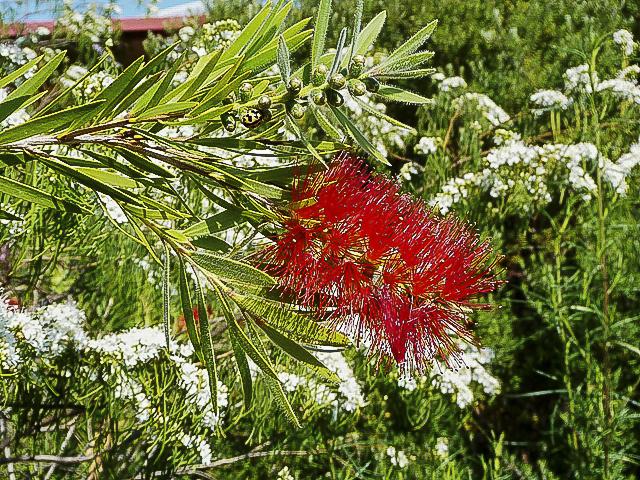
Callistemon ‘Hannah Ray’ is a tall shrub with pendulous branches. Leaves are narrow-lanceolate and new growth is bright pink. In late spring plants produce large, bright red brushes. Honeyeaters flock to the flowers. Remove flowers as they fade. This keeps plants dense and blooming bounteously.
Callistemon formosus
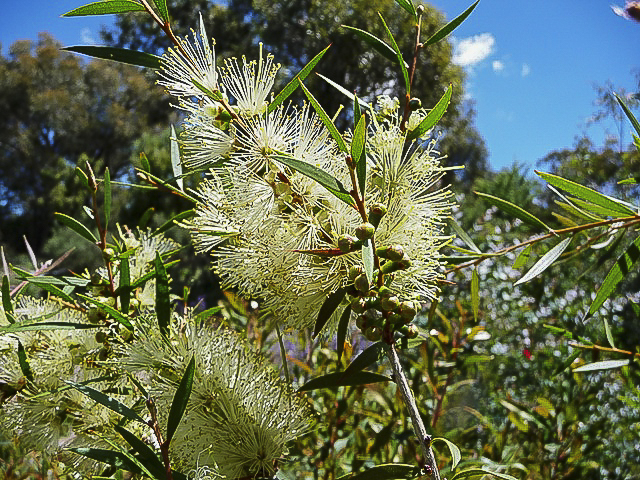
Callistemon formosus is known as the Cliff Bottlebrush or Kingaroy Bottlebrush. The latter common name refers to a town in southern Queensland near where the species occurs. It is a tall shrub that may reach a height of five metres with a spread of three metres and pendulous growth habit. The specimens, in our cold climate garden, are two metres tall four years after planting.
Callistemon comboynensis
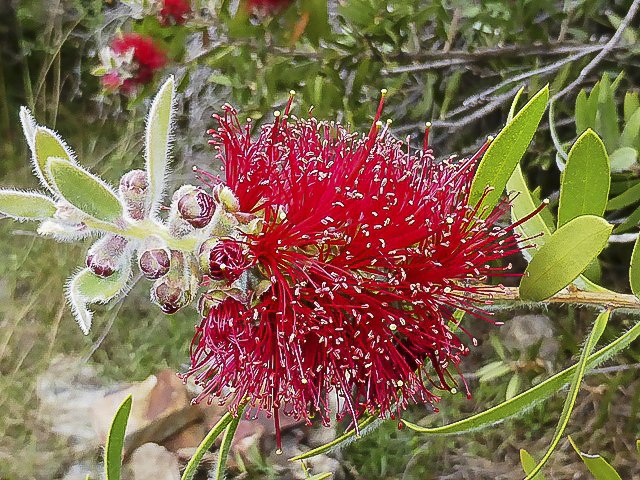
Callistemon comboynensis is known as the Cliff Bottlebrush and grows into a medium shrub reaching a height of three metres. The leaves are narrow to broad-lanceolate, leathery with numerous oil dots. New growth is pinkish. The flower spikes are red, five to nine centimetres long and between four to eight centimetres wide. The main flowering period is in summer and autumn with sporadic flowering at other times.
Callistemon ‘Candy Pink’
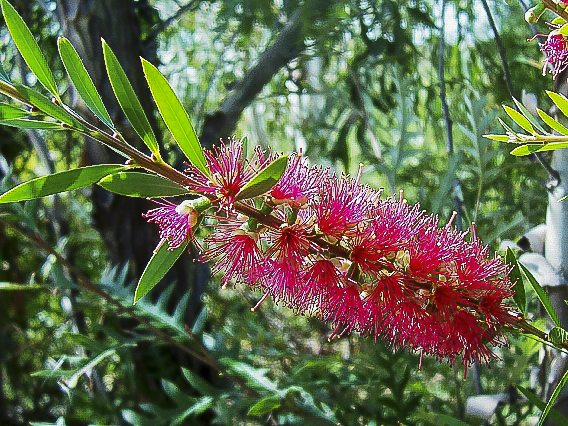
Callistemon ‘Candy Pink’ is a medium to tall shrub that may reach a height of four metres with a spread of three metres. Plants this size tends to be rather straggly with few flowers. ’Candy Pink’ has lance shaped leaves and long, narrow flower spikes. They are pinkish-red fading to pink. There are usually several flowering flushes each year.
Callistemon brachyandrus
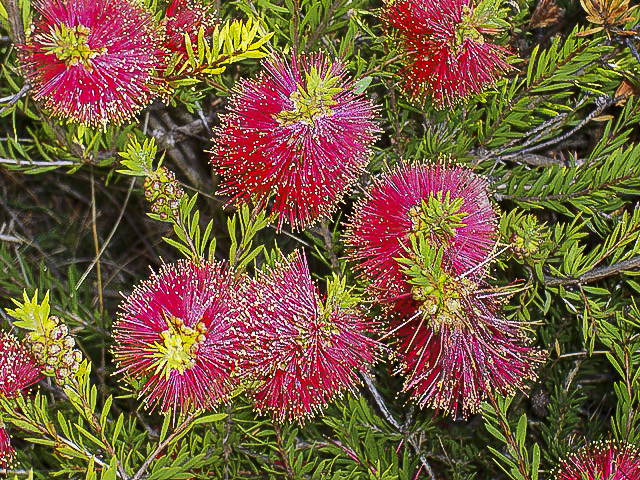
Callistemon brachyandrus has a number of common names including: Mallee Bottlebrush, Prickly Bottlebrush and Prickly Mallee Bottlebrush. It is usually a small to medium shrub with small prickly leaves. Young growth is softly hairy.
Bursaria spinosa
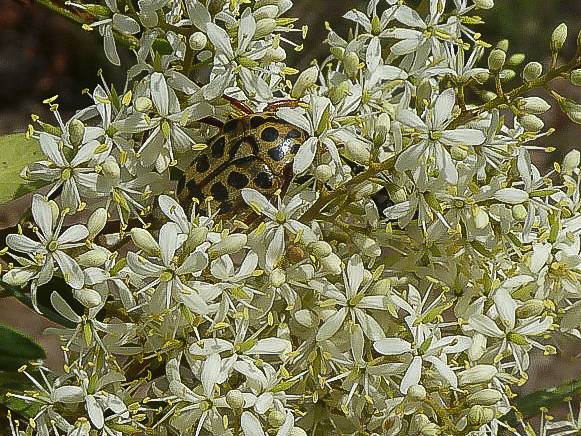
Bursaria spinosa is known as the Blackthorn and also the Tasmanian and South Australian Christmas Bush because summer is the main flowering period of this prickly plant. Blackthorn develops into a medium to tall shrub with oval leaves, shiny on top and dull underneath. The branches carry large spines.
Boronia pinnata
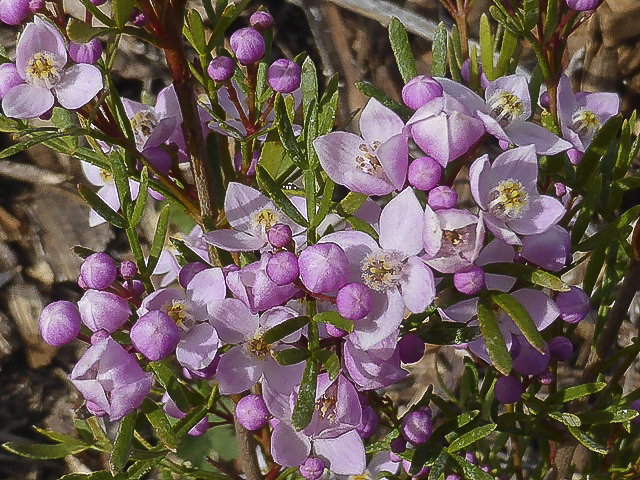
Boronia pinnata is a shrub reaching a height of 1.5 metres. The leaves are pinnate with 5-11 leaflets. The flowers are carried in clusters held in the upper leaf axils. Each flower is about 1.5 centimetres in diameter, four-petalled and pale to deep pink in colour. A white-flowered form is also in cultivation. Flowers are both conspicuous, profuse and appear in spring. Both foliage and flowers are strongly aromatic.
Boronia ‘Carousel’
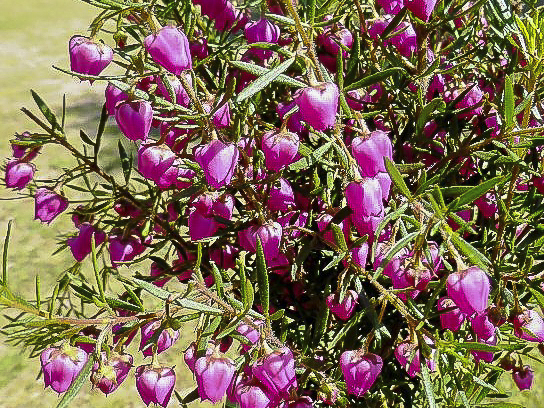
Boronia ‘Carousel’ has an obscure origin. Possibly it was originally selected from the wild in the Albany district of Western Australia. ‘Carousel’ is a tall shrub reaching two metres in height. The pinnate leaves are aromatic, dark green and up to 35 millimetres long. Flowers are bell shaped, 8mm long, bright pink aging to deep red and are both conspicuous and profuse. Flowering occurs from late September to November.
Banksia robur
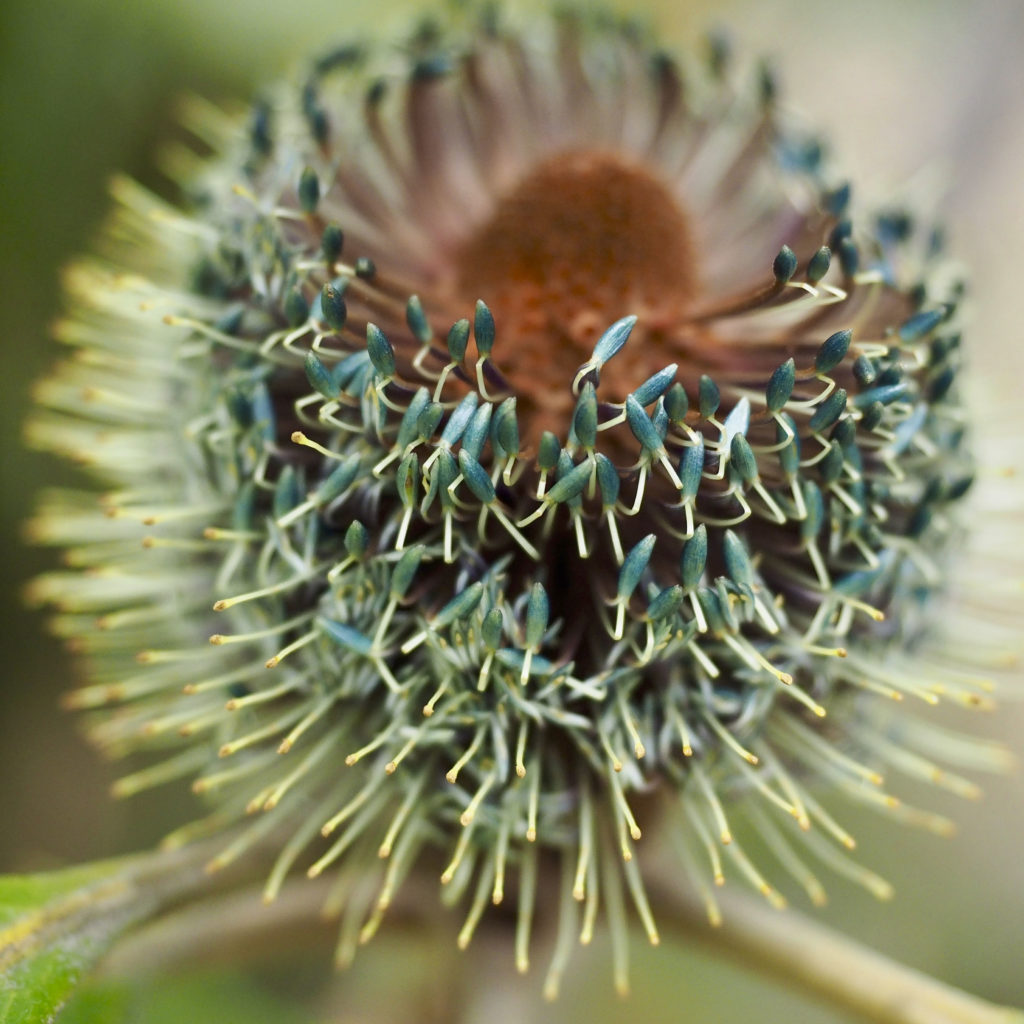
Banksia robur, Swamp Banksia, is a shrub reaching a height of two metres with multiple stems arising from a lignotuber (swollen root mass). Bark is smooth and the branchlets are covered with tangled, rusty hairs. The leaves are large, with toothed margins, glossy green above and light green beneath.
Austromyrtus tenuifolia
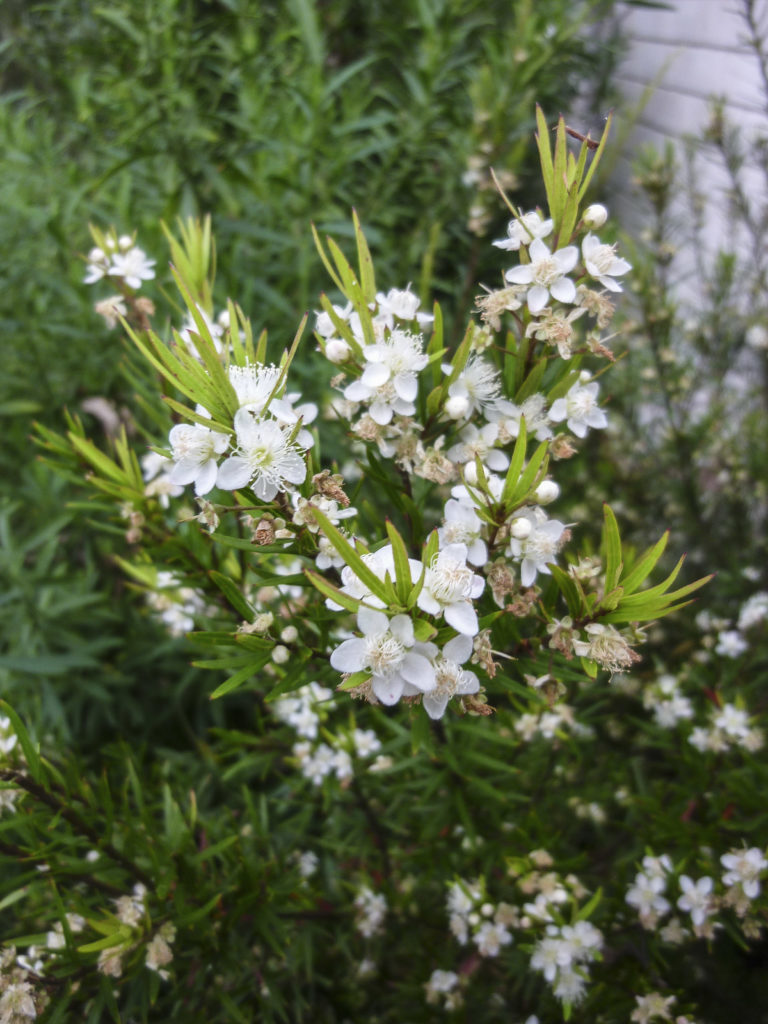
Austromyrtus tenuifolia naturally grows in wet sclerophyll forests, often beside streams or in damp places in the Sydney Basin. My plant, is now many years old and is growing in my northern suburbs Sydney’s garden, on a thinnish layer of soil over a clay base in a position that is often quite dry compared to its natural habitat.
Asterolasia beckersii
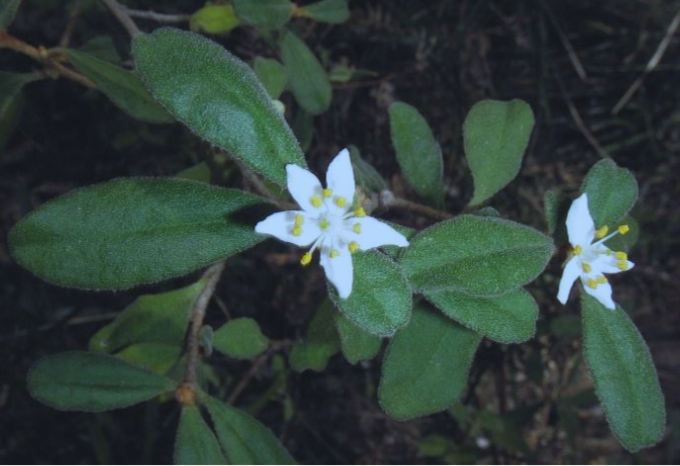
Asterolasia beckersii, or Dungowan Star Bush is a very rare plant from an area near Tamworth, New South Wales and is a member of the Rutaceae family. The Dungowan Star Bush is an erect shrub, reaching a height of two to three metres. The leaves are oblong in shape tapering to the short petiole and have an elliptic lamina. The upper surface is green whilst the lower surface is paler green to fawn. The stems tend to be covered in a rusty brown indumentum.
Archirhodomytus beckleri

Archirhodomytus beckleri belongs to the Myrtaceae family and is the only species of Archirhodomytus growing in Australia. The other four species are from New Caledonia. The common name for this plant is Rose Myrtle and I suspect this name refers to the lovely fragrance of the flowers especially early in the morning before the day warms up.
Alyogyne huegelii
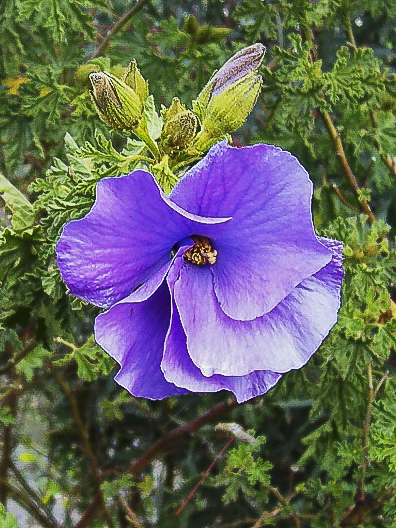
Alyogyne huegelii is member of the Malvaceae (Hibiscus) family and is a medium shrub reaching a height of about two metres with a similar spread. The attractive leaves are hairy, with three to five lobes and dull green in colour. The flowers are large, deep purple and hibiscus-shaped.
Allocasuarina nana
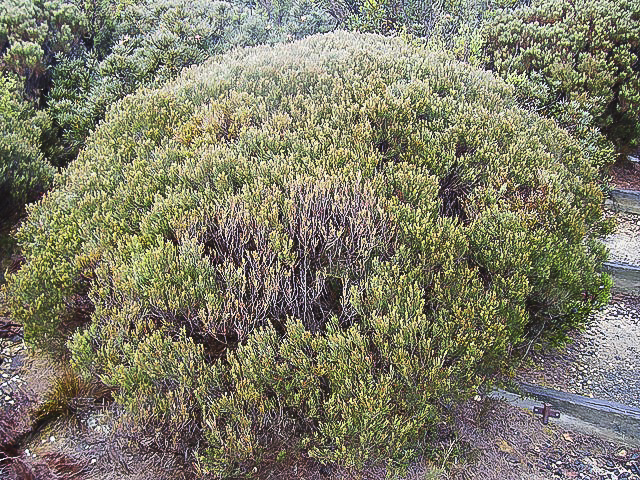
Allocasuarina nana is an attractive small shrub that could be grown as a foreground plant in a native garden bed. The Dwarf Sheoak could also be used as a low, informal hedge in the larger garden. The species would make an excellent native substitute for the ubiquitous, slow-growing English Box in this situation.
Acacia viscidula
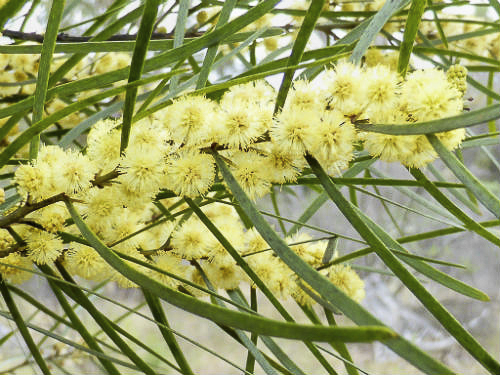
Acacia viscidula, Sticky Wattle, is an erect shrub reaching a height of three metres. Phyllodes are narrow, linear, and leathery with a small hooked point. No glands are visible on the phyllodes. Flower heads are globular, pale yellow and appear from September to November.
Acacia vestita
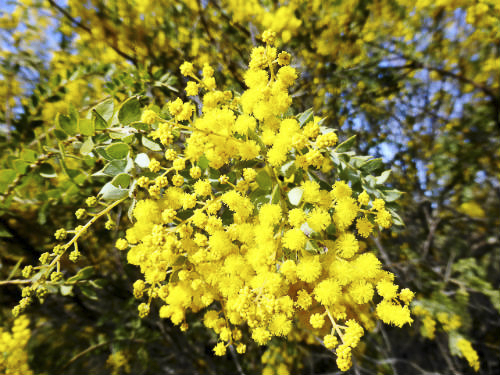
Acacia vestita, the Weeping Boree, is a medium to tall spreading shrub reaching a height of 3 metres with a similar spread. The branches are pendulous and the foliage is grey-green. The golden yellow flowers are held in dense globular clusters. Plants light up with blooms from early August to October. The Weeping Boree is found in a few localities on the Western Slopes and Southern Tablelands of NSW.
Acacia triptera

Acacia triptera is known as the Spurwing Wattle and is found in Queensland, NSW and Victoria. This prickly species will grow into a spreading shrub about two metres tall and the same width. Bright yellow flowers are held in rod-shaped clusters. Flowers cover plants in spring and carried for a number of weeks.
Acacia subulata
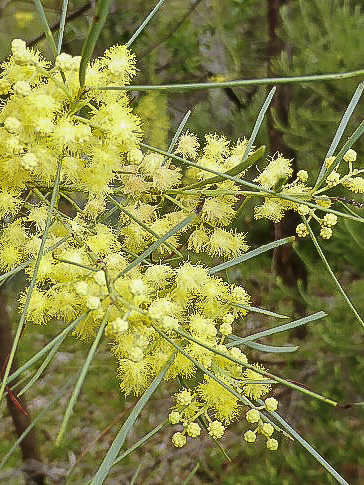
Acacia subulata, the Awl-leaf Wattle, is one of the best of these “out of season” bloomers. The Awl-leaf Wattle is a New South Wales species and grows on the Tablelands and Western Slopes. It grows into a three metre tall, erect shrub. We prune our specimens to keep them to a bushy height of about two metres.
Acacia siculiformis

Acacia siculiformis is known as the Dagger Wattle and is an upright shrub reaching a height of two metres. The common name is apt as the phyllodes are dagger-shaped and come equipped with a sharp point. Individual globular flower heads are held in the axil of each phyllode. Blooms are mid yellow and appear in spring and early summer.
Acacia rupicola

Acacia rupicola is known as the Rock Wattle. This is an appropriate common name because the species name means “of rocky areas”. The Rock Wattle is a rigid, upright shrub that reaches a height of two metres and has slightly sticky foliage and stems.
Acacia pruinosa

Acacia pruinosa, the Frosty Wattle, is a medium to tall shrub. The leaves are bipinnate with 9-20 pairs of pinnules (leaflets) per compound leaf. The pinnules are grey-blue. Globular flower heads carry from 40-60 deep yellow flowers.
Acacia myrtifolia
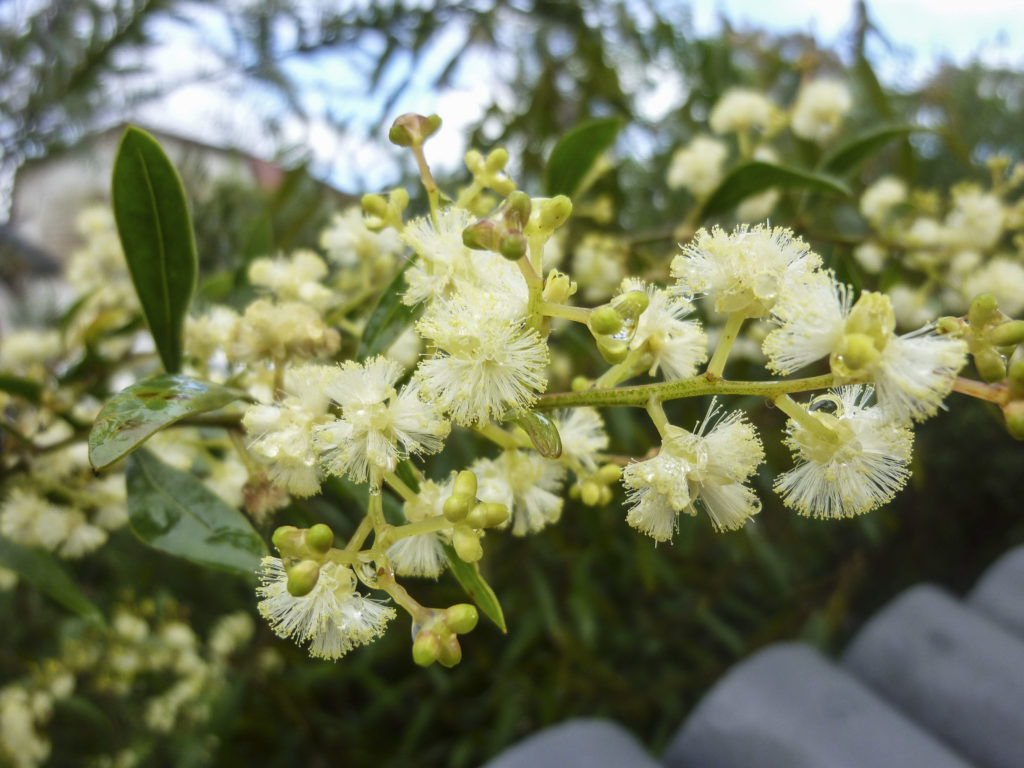
Acacia myrtifolia is a widespread shrub that occurs along the coastal fringe and inland in open forest and woodlands of all States except the Northern Territory It is a dense bushy shrub growing to 1.8m high by the same width with creamy white or pale yellow ball flowers in Winter and Spring. These are followed by 4–7 cm long curved seed pods.
Acacia montana

Acacia montana is known as the Mallee Wattle. This is a medium shrub that reaches a height of two metres in our cold climate garden. The phyllodes are sticky, leathery, up to four centimetres long by one centimetre wide with distinct veins. Flower heads are globular, profuse, conspicuous, bright yellow and appear in spring.
Acacia ‘Little Nugget’
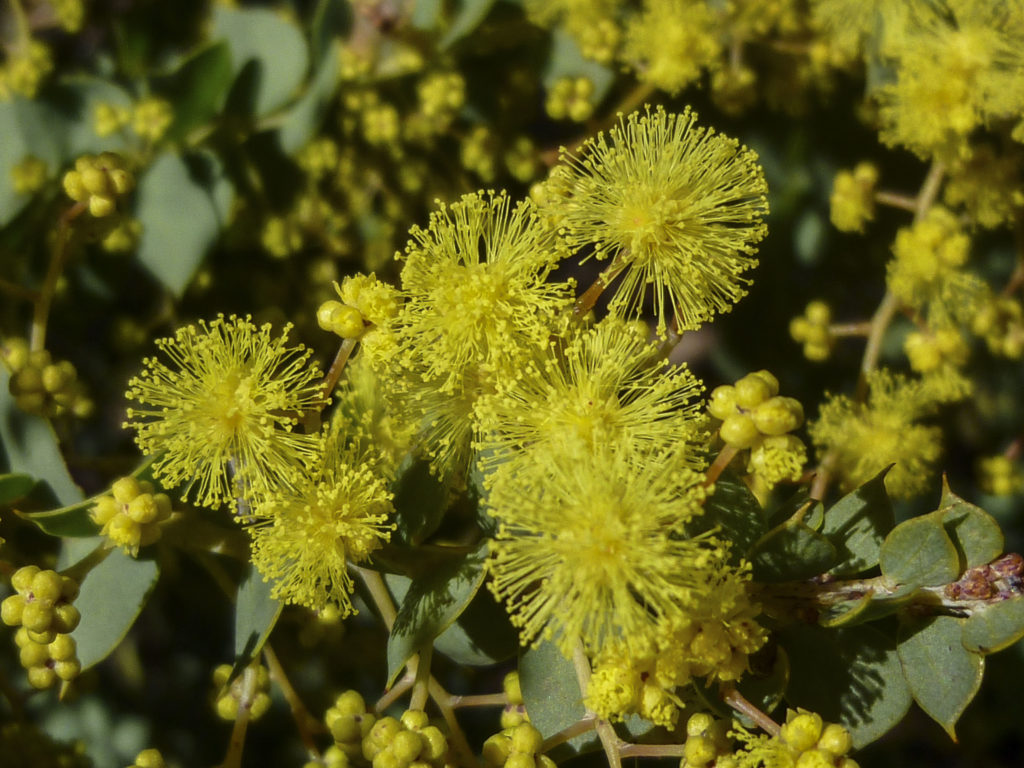
Acacia ‘Little Nugget’ is a hardy, small shrub growing to 1.2 metres tall and about the same width, with clusters of ball-shaped yellow flowers during August to September. Acacia ‘Little Nugget’ is frost hardy, prefers full sun to dappled shade and well drained soils.
Acacia ligulata
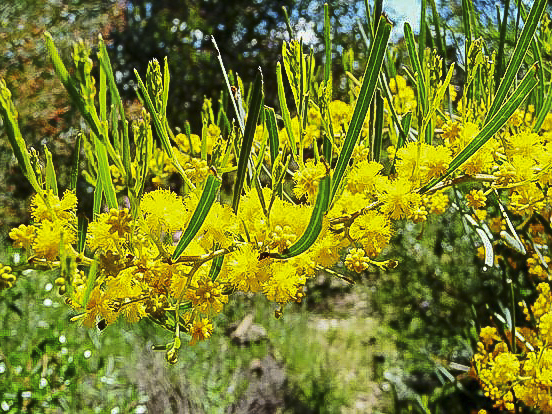
Acacia ligulata is known by several common names including: Dune Wattle, Sandhill Wattle, Small Cooba and Umbrella Bush. It is a rounded, compact shrub that will reach a height of from one to five metres. Our cold climate garden specimen has reached a mature height of 1.5 metres.
Acacia leptoclada
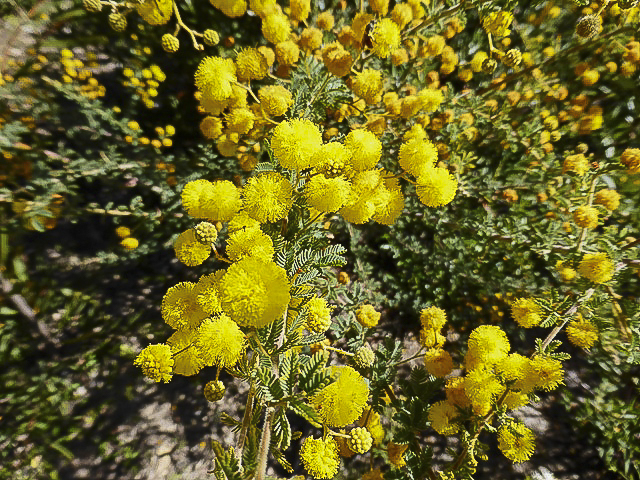
Acacia leptoclada is an attractive, spreading shrub, a native of northern New South Wales. The common name is Tingha Golden Wattle. Tingha is a village near Inverell on the Northern Tablelands of NSW. One of the strongholds of this acacia is the Goonoowigall State Conservation Area. This large, bushland area protects a range of interesting native plants including Acacia leptoclada and is situated near Inverell.
Acacia ixiophylla

Acacia ixiophylla, Sticky Wattle, is a medium, upright shrub. The phyllodes are sticky and about 30 millimetres long by 6 millimetres wide. There is a gland near the base of each phyllode. Bright yellow, globular flowers appear in spring.
Acacia iteaphylla
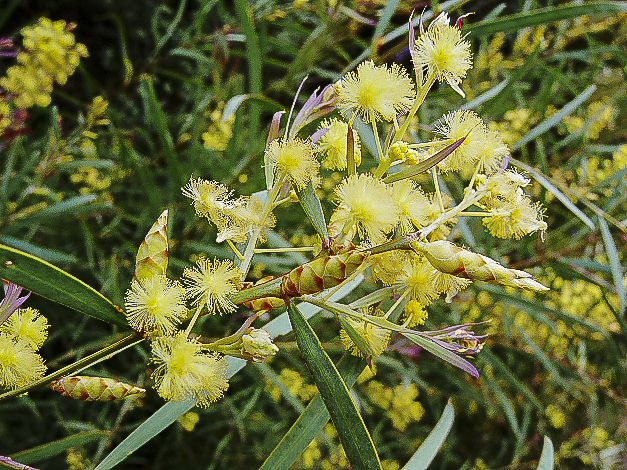
Acacia iteaphylla, the Flinders Range Wattle, is a native of South Australia and comes in several forms. There is a dwarf form and others that are either medium to tall shrubs with upright growth habit or pendulous branches.
Acacia granitica
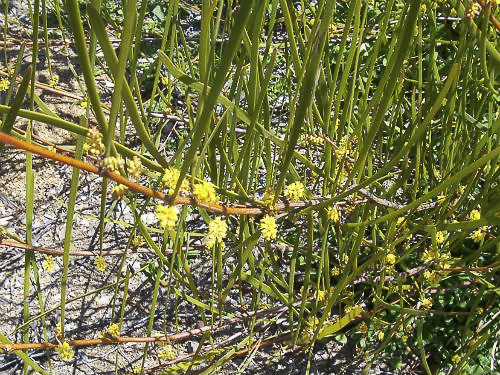
Acacia granitica, the Granite Wattle, comes in two forms. One is a low and spreading shrub with a flat top whilst the other is tall with a rounded growth habit. Both forms have long, narrow, leathery phyllodes with many fine parallel veins. Flower heads are small, ovoid in shape, bright yellow and carried at the base of each phyllode.
Acacia dawsonii
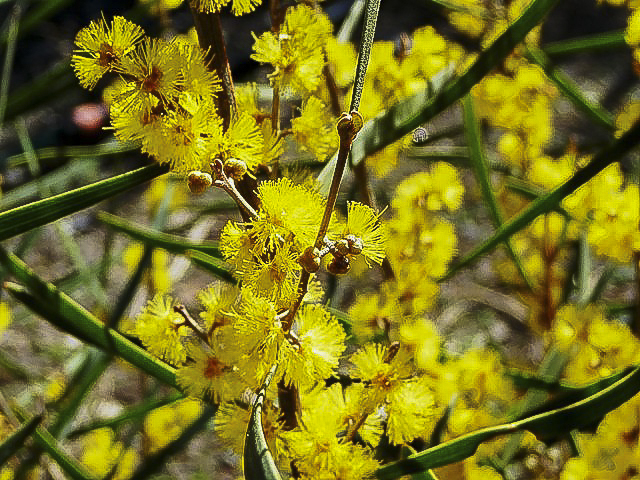
Acacia dawsonii is known as the Poverty or Mitta Wattle, and is a small, erect shrub with long, narrow phyllodes. Golden yellow, globular flower heads cover plants in spring. Each flower head is composed of four to eight individual flowers.
Acacia cultriformis
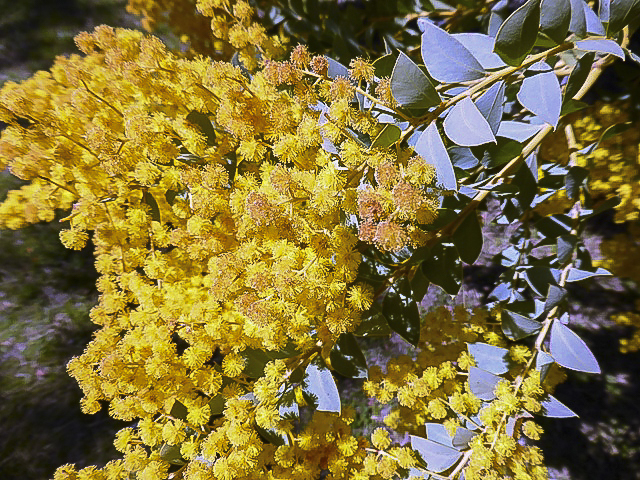
Acacia cultriformis, the Knife-leaf Wattle, is a bushy, medium to tall shrub. The triangular-shaped phyllodes (hence the common name) are crowded along the branches. The size of the phyllode varies from 20 to 30 millimetres long by 6 to14 millimetres wide and bluish green in colour.
